
|
Sale 69
The May Pre-Long Beach Auction
| Lot |
Photo |
Description |
Realized |
Lot 1259 |
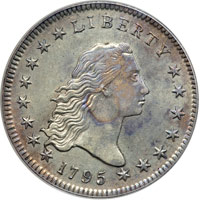 |
1795 B-3, BB-11 Flowing Hair 2 Leaves Silver Plug Rarity 5 (Possibly Rarity 6/7 With Plug). PCGS graded AU-55 PQ. CAC Approved. Subset of PCGS # 6854. In a new secure plus holder. Condition Census. A marvelous example of this desirable variety. Each side exhibits stunning shades of iridescent blue, russet, and gold. The Silver Plug is emphasized majestically by the toning. This piece is truly a miraculous numismatic wonder! The bidder who is fortunate enough to win this coin will undoubtedly be mesmerized by it's sheer beauty. Pop 1; none finer at PCGS for the variety
There is much to recommend this handsome specimen. First and foremost, it uses the desirable Head of 1794. Employing Obverse 1, Libertyís flowing locks are in six curls; the third from the top turns downward and touches the fourth curl. Two points of the first star touch the lowest curl which ends at star point. Finally, the last star or lowest one on the right is mostly under the bust, which a point nearly touches. Close date; there are outlines from repunching that appear at the top of the 5 and right top of the 7 (most visible on early impressions from the die). I closer to L than to B with L slightly low. This obverse die was used to strike 1795 BB-11, BB-12, and BB-13.
It is paired with Reverse A: Two leaves under each wing. The only variety with 16 berries, eight on each branch of the wreath. There are only two berries on the left branch, between the eagle's wing and ribbon bow, both are on the inside of wreath. This reverse die is unique to 1795 BB-11.
A scarce variety, between 31 and 75 1795 BB-11 dollars exist, making this one of the more elusive issues of the Flowing Hair type. In this condition, the coin is King, finest certified, and undoubtedly Finest Known. Noteworthy too, it is at least twice as rare as a 1794 dollar.
The population of 1795 BB-11 seems to be clustered around the VF level which, of course, covers a fairly wide range (VF20 to just below EF40). Specimens are not easy to locate, according to the Bowers encyclopedia, "often a year will pass on the calendar without a single piece crossing the auction block.". (PCGS # 39990)
Story of the Silver Plug Dollars: The curious silver plugs are known on several varieties, but usually on just a few coins of each. It is believed that during the planchet preparation process, sometimes planchets would be slightly underweight, and would normally have to be remelted, drawn and cut to size again. Someone at the Mint decided to use the 1792 silver center cent as an example, and drill out the center of the blank silver dollar planchet, insert a larger silver "plug", and strike the coin normally. The plug would flatten out and become a part of the coin, increasing the weight to the required standard. Ray Merena noted on this specimen that it has not only a silver plug, but also adjustment marks on the lower reverse rim. Why would someone add, then take away weight from the same planchet? Both the silver plug insertion and adjustment marks occurred prior to striking, so we can't be sure which came first, the plug or the adjustment marks.
This particular specimen holds a very special importance among 1795 flowing hair dollars. Coming from the earliest, perfect-state of the dies, from the first die variety of silver dollars struck during 1795, this coin is most certainly one of the very first silver dollars struck during 1795. Among the known population of 1795 dollars with mint-inserted silver plugs, it is undoubtedly the very first one struck; it bears the very longest pedigree chain; and it is the very first specimen to have been described with a mention of the feature we now label as a "silver plug."
In his "Silver Dollars & Trade Dollars of the United States - A Complete Encyclopedia," Q. David Bowers comments in relation to the Winsor-Wilson-Clarke-Ostheimer specimen of the B-7, BB-18 dollar, that "Walter Breen stated that he first noted the silver plug phenomenon "early 1956 on the Windsor-D.S. Wilson-Clarke B-7, but dared not use the word 'plug' or 'plugged' in the description lest it frighten off buyers!" Breen obviously was unaware of the present specimen, then impounded in the Garrett holdings, having already been off the market for more than seven decades. Breen was also unaware that auctioneer Lyman H. Low had recognized the rare feature of the coin in 1885, and like Breen, dared not call it a "plug" but instead described it as having the "planchet rough on bust, and similar defect on rev." (PCGS # 39990) .
Estimated Value $75,000 - 85,000.
Ex: Lyman H. Low�s 8th Sale (June, 1885): Lot 59, bought at the sale by T. Harrison Garrett, Garrett Collection; Stack�s (March, 1976): Lot 245; unknown intermediaries; Phillip Flannagan Collection, Bowers & Merena (November, 2001):Lot 4204, bought at the sale by the Cardinal Collection; Cardinal Collection Sale, American Numismatic Rarities (June, 2005): Lot 6; private collector; privately to the Cardinal Collection January, 2006; privately to Dr. Hesselgesser, February, 2008; The Dr. Hesselgesser Collection.
View details and enlarged photos
Check results on similar lots
| Realized
$103,500 |
Lot 1260 |
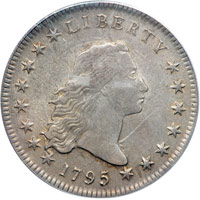 |
1795 B-9, BB-13 Flowing Hair 2 Leaves Rarity 4. PCGS graded AU-55. CAC Approved. Subset of PCGS # 6853. Condition Census. In a new secure plus holder. Flowing hair in six curls; the third one from the top turns downward and touches the fourth curl. Two points of first star touch the lowest curl which ends at star point. The last star or lowest one on the right is mostly under the bust, and a point nearly touches. Close date; outlines from repunching appear at top of 5 and right top of 7 (most visible on early impressions from the die). I closer to L than to B with L slightly low. Obverse die used to strike 1795 BB-11, BB-12, and BB-13.
Two leaves under each wing. 17 berries, nine on left branch, eight on right. A berry is on outside of the wreath midway between S and T of STATES, the only variety in which this occurs; the arrangement is similar to that used on the 1794 dollar. Reverse die used to strike 1795 BB-13 and BB-14. The die clash marks that are evident on this piece are quite intriguing. Although not as obvious as in the BB-11 example offered in this collection, this coin displays some evidence of a mint inserted silver plug; so, while the coin has not been certified as such, prospective bidders should examine the coin closely to come to their own opinion.
Pop 1; none finer at PCGS for the variety (PCGS # 39980) .
Estimated Value $25,000 - 30,000.
The Dr. Hesselgesser Collection.
View details and enlarged photos
Check results on similar lots
| Realized
$28,750 |
Lot 1261 |
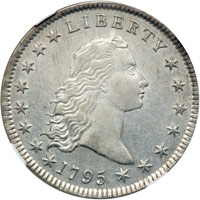 |
1795 B-4, BB-14 Flowing Hair 2 Leaves Rarity 3. NGC graded AU-58. Subset of PCGS # 6853. Condition Census. On this obverse, star 15 is "hidden " entirely under the bust, where, anthropormorphizing Miss Liberty, she cannot "see" even a part of it; the only 1795 obverse with this characteristic. Flowing hair in six curls; lowest curl ends faintly above two points of first star, and close to one point. Close date, figures 9 and 5 closest, and the distance between the 1 and 7 about the same as between the first star and figure 1. Obverse die used to strike 1795 BB-14 only.
Combined with Reverse C die used to strike 1795 BB-13 and BB-14.
1795 BB-14 is one of the more readily available issues of the year. The specialist will have no trouble acquiring a specimen in just about any grade up to VF. At the EF level, BB-14 becomes somewhat elusive, but a specimen in this grade can usually be acquired easily with less than a year's search. AU coins are rare, and Mint State examples are very rare.
According to the Bowers encyclopedia, "The rims on this issue are higher than most other 1795 dollars, giving them a somewhat more "modern" appearance than the typical variety of this year. Planchet adjustment marks are not often seen on BB-14. A few pieces I have seen have had black carbon streaks, the result of improper alloy mixing. Probably a batch of 1795 BB-14 dollars was made from an impure alloy melt.
"The only known 1795 dollar overstruck on a previously coined 1794 is of the BB-14 variety and is described at length below. This suggests that 1795 BB-14 was probably included among the first dollars minted in 1795. As such it helps verify the varieties listed in Striking Period 1 were the first struck." Pop 1; none finer at NGC for the variety. Just a single mint state example is known of the B-4, BB-14 dollar. That marvelous specimen has been graded by PCGS as MS62+, and it is currently impounded in a long term collection, and thus unlikely to be available to collectors within the foreseeable future.
Dr. Hesselgesser's Comment: This is the finest BB-14 that I have seen over the last 40 years!
Estimated Value $25,000 - 30,000.
The Dr. Hesselgesser Collection.
View details and enlarged photos
| Realized
$31,050 |
Lot 1262 |
 |
1795 B-20, BB-16 Flowing Hair 2 Leaves Rarity 8. PCGS graded VF-35. Subset of PCGS # 6853. In a new secure plus holder. Condition Census #1 of only 3 known specimens. This piece is the only gradeable BB-16 example. The other known pieces are damaged. An exquisite rarity. Both sides display impressive bluish steel toning with golden accents. A lovely example of this elusive item. Pop 1; none finer at PCGS for the variety.
The Hesselgesser Bust Dollar Collection is historically significant in that the quality of these first silver dollars struck by the U.S. Mint is amazing. The current collection contains a nearly complete set of varieties, many of which are the finest known. This is notable because the variety series for early U.S. dollars is difficult to obtain in grades of Extremely Fine or higher. The Hesselgesser Collection has drawn rave reviews whenever it has been displayed. An amazing number of the coins qualify as condition census according to the Bowers-Borckardt silver dollar book or more recent references. The originality of these coins is remarkable in toning, luster and overall eye appeal while adjustment marks are minimal.
The present offering is the famed B-20, BB-16 Flowing Hair dollar. Diagnostics include a perfect curl that touches the inner point of star 1; there is a die scratch from a denticle left of A2. At a glance a specialist will recognize the obverse die, with the delicate curls on Liberty and much more artistic rendering of her profile than on other varieties this year. This obverse die was paired with a three leaves reverse, a variety which is fairly common. However, the obverse die was also paired with this reverse, which was used on the B-8, BB-15 variety which is extremely rare, and the B-20, BB-17 variety which remains unique.
Again, we are honored to offer one of the great rarities in American numismatics, and also one of the most elusive Bust dollars of them all. There are three examples of this die marriage know. The variety first came to light when a low-grade example sold in a Lester Merkin February 1972 sale. That particular coin was graded as Fine-15 in the Bowers Borckardt Encyclopedia. A second specimen was auctioned by Bowers and Merena in 1997. Jules Reiver purchased this coin privately from the Cardinal Collection (via Early Dollar specialist John Haugh) in 1998. That coin is holed. A third example was discovered and auctioned in March of 2000 by Bowers and Merena, but this coin also has initials in the fields. A great rarity and a desirable coin as the only example certified by one of the major grading services, and clearly waiting for a strong buyer to step up to the plate and submit a winning bid. It may require a very substantial source of funds to do so, but the next owner will have the honor (and prestige) of attaching his name to the Provenance record of this, the finest B-20, BB-16 1795 Flowing Hair Dollar of them all!
Of particular interest to the specialist in this series is the fact that most of the known examples of these extremely rare die pairings are damaged to some degree, often with initials in the fields or holes, or both. Furthermore, several are double struck. This raises more questions with each new specimen that turns up. Why are so many of the surviving examples of great rarities damaged, double struck or holed? The number of damaged coins seems to vastly exceed the norm for the date or period. Collectors of die varieties would love to have a selection of high grade pieces to choose from to represent each pairing, but this is simply not the case especially for the rare 1795 and 1796 varieties. Thus, any collector who desires to own an example of this rarity would do well to secure this perfect coin (PCGS # 39983) .
Estimated Value $70,000 - 80,000.
The Dr. Hesselgesser Collection.
View details and enlarged photos
Check results on similar lots
| Realized
$65,550 |
Lot 1263 |
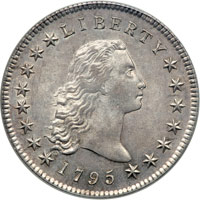 |
1795 B-7, BB-18 Flowing Hair 3 Leaves Rarity 3. PCGS graded AU-58 PQ. In a new secure plus holder. Condition Census. A superlative example of this desirable variety. This coin was struck with such precision that it is hard to believe it is from the 18th century! Razor sharp devices and shimmering luster leave the viewer breathless while looking at this astounding creation. Tremendous pizzazz.
A remarkably memorable coin that at one and the same time is a highlight specimen of this date as well as its variety. Thoroughly frosty and largely untoned, with just a faint ghost of golden color. The luster is spectacular and extensive, especially satiny on the reverse. Only the uppermost portions of the design show it retreating before some slight circulation war (notably, the hair above Liberty�s ear). The strike is definitive, with full centers to each star and exquisite detail everywhere but absolute centers. Centering is outstanding as well. No adjustment marks seen. The strike is bold enough and the freshness in the fields is pronounced enough that it is perhaps unsurprising the grading service awarded the coveted AU58 grade. No contact marks, even minor ones are visible. In terms of quality, this is the sole occupier of its category. Its technical detail, suitability for purchase, and impeccable aesthetic appeal make this a natural choice for a Bust Dollar collector. Pop 1; none finer at PCGS for the variety (PCGS # 6852) .
Estimated Value $40,000 - 50,000.
The Dr. Hesselgesser Collection.
View details and enlarged photos
Check results on similar lots
| Realized
$46,000 |
Lot 1264 |
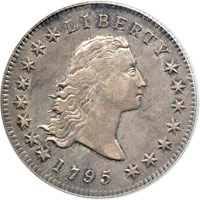 |
1795 B-1, BB-21 Silver Plug Flowing Hair 2 Leaves Rarity 2. PCGS graded AU-53 CAC Approved. Subset of PCGS # 6854. In a new secure plus holder. Fully toned in pale golden lilac and intermingled gray shades. An aesthetic prize that is the byproduct of decade after decade of careful stewardship. Well struck with full star centers and only a bit of flatness in the hair curls and an oval of softness on the eagle's breast. No marks, substantial, minuscule, or otherwise yielding what most would describe at truly pristine fields. A few individual adjustment lines are present atop the reverse eagle, and when magnified scrutiny will reveal most have disappeared as the eye moves away from the center.
This coin (were it not for the silver plug) would lie within the Condition Census for the variety or very close to it. During the pre-1993 research for the Bowers Encyclopedia, one piece included in the listings of "notable specimens" was a MS-64 and second finest known. The Stackís 1984, Stackís 1990, and 1945 Boyd coins all appear to be nice Mint State pieces, but after those few the Census becomes quickly engulfed with pieces in the AU range. However, collectors like to separate the few specimens With Silver Plug into a special side category, and for obvious reasons!
Variety Notes: BB-21 represents one of several varieties with the two-leaves reverse and the Head of '95 obverse. On the obverse, Liberty's lowest curl is nearly closed and touches a point of star one, visually extending that star point. The reverse displays 19 berries on the wreath, nine on the left branch and 10 on the right, with three berries beneath the eagle's wing on the left and four berries beneath the wing on the right (including one berry on the outside right, below the I in AMERICA). Pop 1; none finer at PCGS for the variety (PCGS # 39994) .
Estimated Value $50,000 - 60,000.
The Dr. Hesselgesser Collection.
View details and enlarged photos
Check results on similar lots
| Realized
$46,000 |
Lot 1265 |
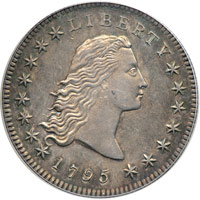 |
1795 B-10, BB-22 Flowing Hair 2 Leaves Rarity 7. PCGS graded AU-58 PQ. CAC Approved. Subset of PCGS # 6853. Condition Census. In a new secure plus holder. This coin was previously graded MS61 by NGC. Second year of issue and a rare die pairing. Liberty facing right, flowing hair behind her head, LIBERTY above, date below, with stars arranged eight to the left and seven to the right. Reverse with eagle perched on a rock, enclosed by a wreath, open at the top, and with three leaves projecting upward beneath the wing of each eagle.
The Flowing Hair type dollar was short lived and was produced only in 1794 and 1795. No doubt a greater mintage would have occurred in the former year, except that a press of insufficient capacity was all that was on hand, and the coins could not strike up satisfactorily. Accordingly, mintage in quantity was postponed until proper equipment could be obtained. The Flowing Hair dollars encompass many interesting die varieties.
BB-22 is a landmark rarity. On the obverse, the numeral 7 is repunched over a 1; on the reverse, there is an outer berry below C and an inner below the final A in AMERICA. The surfaces are immaculate and beautifully toned, with a thin layer of gold toning over the underlaying medium gray. Remarkable is the strike which, save for a few dentils in the eagleís breast is far from typical for this variety. That is to say, devices are bold throughout. Whatís more, there are no adjustment marks, which puts this in the lead for those who would prefer not to see parallel lines in the surface of their coins. The adjustment marks came about before the coin was struck. But because there are none here, weíll omit describing how commonplace they are to early Flowing Hair dollars and save our description for another consignorís coin that may involve them.
This particular specimen shows strong feathers on the eagle's wings and tail. Problem-free surfaces for the grade assist anyone in making the major decision whether or not to bid. With no other significant nicks or bumps and even devoid of the usual handling marks, this coin is a leader in its class.
Variety collectors will learn that the 1795 silver dollars are one of the most challenging in the series to complete by variety. Of these known 22 varieties, one is believed to not exist (B-17), and another nine die pairings are considered to be R.7 to unique! And several of these are known with the curious "silver plug" located at the center of the coin.
A wonderful opportunity for the Variety Set collector to acquire one of the highest-quality examples of this important early coin. Pop 2; none finer at PCGS for the variety. This is the Finest Known of the die marriage by at least 30 points. This remarkable coin deserves a Mint State grade. While the PCGS Population shows 2 in AU58 for the variety, BOTH represent this one coin. There is no other AU58 (or higher) coin for the variety. Although not as obvious as in the BB-11 example offered in this collection, this coin displays some evidence of a mint-inserted silver plug; so, while the coin has not been certified as such, prospective bidders should examine the coin closely to come to their own conclusion (PCGS # 39987) .
Estimated Value $75,000 - 85,000.
Ex: WGC/F.C.C. Boyd; Ex: Harold Bareford; The Dr. Hesselgesser Collection.
View details and enlarged photos
Check results on similar lots
| Realized
$66,700 |
Lot 1266 |
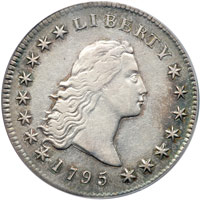 |
1795 B-6, BB-25 Flowing Hair 3 Leaves Missing Leaf Rarity 8. PCGS graded EF-45. Subset of PCGS # 6852. In a new secure plus holder. Condition Census. Attractive prooflike surfaces. Pop 1; none finer at PCGS for the variety. The only example graded at PCGS of this intriguing variety. Please compare areas that are boxed on the reverse of the regular BB-25 and the missing leaf BB-25.
Flowing hair in six curls, 3rd and 4th close together; lowest curl barely misses a point of first star, but continues on to touch and slightly pass a second point of same star. The second curl from bottom turns downward pointing to space between two points of second star. Wide date, 79 closest. E in LIBERTY punched over an earlier erroneous R. The Y in LIBERTY is higher than the adjacent T. Foot of R in LIBERTY shortened from a broken punch. Obverse die used to strike 1795 BB-24 (early state) and BB-25 (early and late states).
Three leaves under each wing of eagle. 13 berries, seven on left branch, six on right. Two berries under first T in STATES, one on inside and one on outside of wreath. Die State I has three leaves visible below first S of STATES. Die State III with four leaves; also used in its later state to coin BB-26 and BB-27, each of which has four leaves beneath the first S of STATES.
Reverse die used to strike 1795 BB-25 (two states; Die State I with three leaves and Die State III with four leaves under first S in STATES), BB-26 (later state with four leaves under first S in STATES), and BB-27 (later state with four leaves under first S in STATES).
Die State I: Two specimens are known to the writer. The first is Frank M. Stirling's discovery piece, which from the illustration in The Numismatist appears to be EF. The second is that included in Stack's sale of the Spies Collection, December 9-10, 1974, Lot 19, and described as prooflike EF, with a few faint scratches between the 1 and 7 of the date.
Die State II: Transitional state. Not seen by the author.
Die State III: It is believed that 201 to 500 specimens of 1795 BB-25, Die State III, exist, most of which are in lower grades through VF.
The rims are usually indistinct in portions, with some areas appearing flattened; weakness is usually seen at the rim beginning about the 8th star and continuing over LIBE, and from the 13th star, the date, to the 1st or 2nd star; on the reverse, the weakness is most often seen at the rim above UNI and OF AME. Most specimens are weak at the obverse center in the area of Miss Liberty's ear (which is usually not visible), and on the eagle's breast.
In the opinion of Early Dollar expert Martin Logies, the re-working of the reverse die following this early die state is so extensive that the "Die State I" examples should be recognized as a separate die variety.
This is the discovery coin made by Frank Stirling in 1952. At the time it was given a separate Bolender number 18 but then was found to be a die state of B-6. Now this is where it gets tricky. The three leaf or missing leaf is located on the reverse under the first S in STATES! This reverse A was used for only a short time - ONLY TWO SPECIMENS HAVE BEEN FOUND - the original Stirling specimen and the Spies's specimen sold in 1976 which has never been seen since! The Missing Leaf was called this because it was once believed that the common 4 leaf variety was struck with some material plugged in the fourth leaf making it disappear (see Bowers and Borckardt's Book). This is NOT TRUE as noted in the July 2007 issue of the, "Rare Coin Market Report" where John Dannreuther goes through the sequence of die varieties used! The Missing Leaf was the first use of the obverse and reverse followed by use in the B-13, BB-24 (Obverse used but with significant changes in the DATE, especially 795); B-12, BB-26 (Reverse B used now with an added 4th leaf under first S in STATES); B-5, BB-27 (same 4 leaf Reverse B); and THEN back to the B-6, BB-25 but with the reworked Obverse and the added 4th leaf Reverse B. So does this make it a different variety? I say it does! PCGS even gave it a different #148300 as oppose to the usual B-6, BB-25 #39975! Rarity 8. The finest of the two known and the Frank Stirling Discovery Coin.
Estimated Value $75,000 - 85,000.
The Dr. Hesselgesser Collection.
View details and enlarged photos
| Unsold |
Lot 1267 |
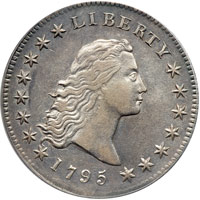 |
1795 B-6, BB-25 Flowing Hair 3 Leaves Rarity 3. PCGS graded AU-53. Subset of PCGS # 6852. In a new secure plus holder. Finest Certified. Condition Census. This is a somewhat confusing die variety because of the two dies states found on the reverse. The coin in Dr. Hesselgesser's collection is from Die State III with four leaves below first S in STATES. An elevated degree of sharp detail springs forth from the sleek medium gray surfaceslighter gray highlights. Never yielding at the obverse or the reverse, more detail can be found there than on the typical example of the date. A rock-solid coin that will advance any high quality set of early Silver Dollars.
Three leaves under each wing of eagle. 13 berries, seven on left branch, six on right. Two berries under first T in STATES, one on inside and one on outside of wreath. Die State I has three leaves visible below first S of STATES (early state of die, probably with 4th leaf depression in die filled with foreign matter). Die State III with four leaves; also used in its later state to coin BB-26 and BB-27, each of which has four leaves beneath the first S of STATES.
Reverse die used to strike 1795 BB-25 (two states; Die State I with three leaves and Die State III with four leaves under first S in STATES; presumably, one of the leaf recesses in the die was clogged, thus preventing one leaf from striking up), BB-26 (later state with four leaves under first S in STATES), and BB-27 (later state with four leaves under first S in STATES). Pop 1; none finer at PCGS for the variety (PCGS # 39975) .
Estimated Value $18,000 - 20,000.
The Dr. Hesselgesser Collection.
View details and enlarged photos
Check results on similar lots
| Realized
$21,850 |
Lot 1268 |
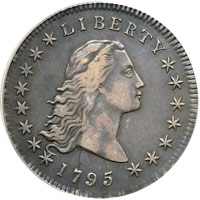 |
1795 B-12, BB-26 Flowing Hair 3 Leaves Rarity 5. PCGS graded EF-40. Subset of PCGS # 6852. In a new secure plus holder. Condition Census. Medium silver gray surfaces intermingled with light rubbed silver high points on the design, combining to create an attractive mélange. Outstanding mark-free originality and detail, including peripheries. And where you would expect to find some adjustment marks, there are none, a singular blessing.
Though rare as a variety, this piece is also struck from a rare die state that shows a strong vertical crack from central obverse through the angle of the 7 in the date to the rim. Bolender owned a worn specimen, the only one he knew of, that came from the famous 1907 Matthew Stickney sale by Henry Chapman. The Flannagan collection contained a piece described as Fine with dents, and Bolender and Reiver both called the die state Rarity-7. Breen, cataloger of the 1973 Superior sale which featured lots pedigreed to the Ostheimer Collection, knew of only the piece in that collection and one other as examples of the terminal state. Regardless of its die state, the present specimen ranks as the apparent finest known specimen, the only piece finer than Bolender's EF early die state coin and the Vfs and Fines that fill the rest of Bowers'"notable specimens" list. An important specimen on several counts.
Variety Notes: BB-26 represents one of several varieties with the three-leaves reverse and the Head of '95 obverse. On the obverse, Liberty's lowest curl is open, touches a point of star one, and continues beyond. The reverse displays 13 berries on the wreath, seven on the left branch and six on the right, with three berries beneath the eagle's wing on the left and two berries beneath the wing on the right. Pop 1; none finer at PCGS for the variety (PCGS # 39976) .
Estimated Value $18,000 - 20,000.
The Dr. Hesselgesser Collection.
View details and enlarged photos
Check results on similar lots
| Realized
$13,800 |
Lot 1269 |
 |
1795 B-12, BB-26 Flowing Hair 3 Leaves Rarity 5. PCGS graded VF-25. Subset of PCGS # 6852. In a new secure plus holder. EDS. Previously graded VF30 by NGC. A more than moderately smooth and attractive specimen light gray surfaces and a confident, no-compromises look of careful preservation by its former owners. Everything you would want from the grade, and probably then some.
1795 BB-26 is believed to exist to the extent of 31 to 75 coins, most of which are in lower grades up to and including VF. Fine grade seems to be about par for this variety, an issue which must have circulated very extensively. The variety is very rare EF and unknown in Mint State. Any specimen which grades EF or higher is Condition Census level. The absence of the obverse die crack is quite desirable. This reverse is also used in the BB-27 and BB-25 (PCGS # 39976) .
Estimated Value $5,000 - 6,000.
Ex: Jules Reiver Collection; The Dr. Hesselgesser Collection.
View details and enlarged photos
Check results on similar lots
| Realized
$5,290 |
Lot 1270 |
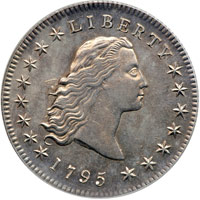 |
1795 B-5, BB-27 Flowing Hair 3 Leaves Rarity 1. PCGS graded AU-58. Subset of PCGS # 6852. In a new secure plus holder. A desirable coin in any About Uncirculated grade, and this top-end AU58 example will certainly generate the requisite amount of excitement when it crosses the block. Toned with delicate gray over the smooth surfaces, with Liberty's head a touch sharper than average with strong hair accents on temple and above the ear; all is framed with even dentils on both sides. The fields and devices are remarkably clean for a Flowing Hair dollar, and anyone who gives this more than a swift glance examining the fields and devices will assuredly be thrilled with the superior quality found here. The fields and devices show residual luster from the original die polish used to prepare the dies for coinage. Devoid of adjustment marks. Identifiable by a small horizontal flaw below the L of LIBERTY on the obverse, and a lighter flaw or mark on the reverse at the eagleís thigh. A magnificent coin for the specialist, which boasts grand eye appeal, top-notch conservative grading quality and a boldness where it counts; all qualities desired but seldom seen in these large Flowing Hair crowns of the world. This is considered to be the most available die pairing of the year, but due to the condition, the present coin is a stand-out and will certainly rank within the top 100 coins of this date. Desirable Three Leaf reverse. (This die pairing produced an estimated 100,000 coins, which is as high as any pair of dies from the first decade at the Mint.) Pop 2; 1 finer in 64 for the variety.
In the opinion of Martin Logies, "This is a truly extraordinary coin, FAR superior to what is typically seen as graded AU58. While the coin does display what may be described as "high-point friction," it otherwise displays all of the luster, eye appeal, and freedom from surface marks of specimens grading MS64" (PCGS # 39977) .
Estimated Value $60,000 - 70,000.
Ex: Garrett Collection; The Dr. Hesselgesser Collection.
View details and enlarged photos
Check results on similar lots
| Realized
$63,250 |
Lot 1271 |
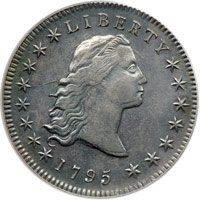 |
1795 B-5, BB-27 Flowing Hair 3 Leaves Rarity 1 Obverse Double Struck. PCGS graded EF-45. Subset of PCGS # 6852. In a new secure plus holder. Taking into account that the obverse is double struck this coin is considerably more scarce than the rarity of the BB variety indicates. A sleek, original toned example whose medium gray patina goes nicely with clear features on Liberty and the eagle and almost ostentatious eye appeal from never having been mishandled in any way. Former owners must have realized this is a special coin. Don't mind the hint of weakness at the hair above Libertyís ear for this is typically seen due to the high relief of the head punch used, and has been taken into consideration by the grading service. Picture-perfect rims serve to form a frame around the coinís exquisite artistic features.
("As is the case with the obverse die used to coin BB-21, BB-22, and BB-23, the present obverse had the head of Miss Liberty deeply impressed into the die, causing it to be in slightly higher relief than other varieties of the year; because of this, the hair details wore away quickly as the coins circulated." -- Bowers encyclopedia. Pop 3; 11 finer at PCGS for the variety (PCGS # 39977) .
Estimated Value $15,000 - 17,000.
The Dr. Hesselgesser Collection.
View details and enlarged photos
Check results on similar lots
| Realized
$13,800 |
Lot 1272 |
 |
1796. Small Date Large Letters B-4, BB-61 Rarity 3 NGC graded XF Details. Improperly cleaned. Light gray which has pleasing overall eye appeal despite minor cleaning. The above-average strike complements this and, some might say, adds nicely to the appearance. The Draped Bust, Small Eagle pieces are the most difficult to acquire. They were struck in the years 1795-98, with each year�s coinage showing fascinating and sometimes unusual characteristics from the hand-made dies. The dies which struck this used small-date numeral punches for the date with large letter punches for the reverse legend.
Estimated Value $2,900 - 3,100.
View details and enlarged photos
| Realized
$3,565 |
Lot 1273 |
 |
1796 B-3, BB-62 Small Date Small Letters Rarity 8. PCGS graded Fine-15 PQ. Subset of PCGS # 6859. In a new secure plus holder. This coin was previously graded VF25 by NGC. Condition Census. This piece is one of two BB-62 examples known to exist. This uses the obverse having made the transition to Die State III of 1796 BB-61. The stars are small and the last two or three are spidery. Curl on top of the head defective. Relapping removed part of Liberty's top curl, and some of the part of the stars in lower relief, making them appear smaller. This obverse was used to strike 1796 BB-61 (early state) and BB-62 (late state).
BB-62�s reverse (described in the Bowers encyclopedia under 1795 BB-51), has a Small Eagle. Small Letters in legend combination. The eagle stands on clouds, while below and to the sides, the wreath is composed of a palm branch (right) and olive branch (left), the latter with seven berries. A short, prominent die scratch extends up to left from tip of right, inside leaf below (observer's) left wing. Berry under A of STATES; a quick way to identify this reverse.
"Bolender reported that some letters were bifurcated on examples he had seen of 1796 B-3 [BB-62], and thought this meant that the die had been "touched up" (however, bifurcation is an idiosyncrasy of striking, and has nothing to do with the die variety or state)," explains Bowers.
Reverse die used to strike 1795 BB-51; 1796 BB-62, BB-63, and BB-66 (now relapped); 1797 BB-72; and 1798 BB-81.
Bolender wrote this in 1950: "While many 1796 dollars have been listed as [B-3; BB-62], this has been erroneously done. I have purchased a dozen or more [B-3; BB-62], every one of them wrongly attributed. Only three specimens are known to me."
The rarity of 1796 BB-62 approaches legendary proportions. In fact, it has kept out of sight so well that many specialists have never seen an example. The fifth revised edition (1988) of Bolender's The United States Early Silver Dollars noted the following: "Most experts now question whether this variety actually exists."
In a conversation, Jules Reiver related that over the years a dozen or more 1796 "Bolender-3" dollars have been offered to him, but without exception they were all misattributed." I don't believe that B3 [BB-62] exists," he concluded. Pop 1; none finer at PCGS for the variety.
Estimated Value $45,000 - 50,000.
The Dr. Hesselgesser Collection.
View details and enlarged photos
| Realized
$60,000 |
Lot 1274 |
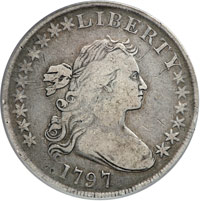 |
1797 B-3, BB-71 Rarity 2. PCGS graded Fine-12 CAC Approved. Light even grey toning with even wear on the main features of Liberty and eagle. Has a few old shallow scuffs in the obverse field. The field itself supports medium-gray color while the high points exhibit light silvery gray by way of contrast. Very appealing. This is the scarce Draped Bust, Small Eagle Red Book type, a coin high on the want lists of many collectors. Seldom available in choice circulated condition without problems (PCGS # 6865) .
Estimated Value $2,700 - 2,900.
View details and enlarged photos
Check results on similar lots
| Realized
$3,105 |
Lot 1275 |
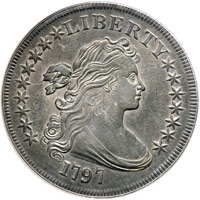 |
1797 B-1, BB-73 Draped Bust 9X7 Stars Large Letters Rarity 3. PCGS graded AU-55. Subset of PCGS # 6863. In a new secure plus holder. Condition Census. Previously graded AU58 by NGC. There are some interesting varieties of the 1797 dollar, mostly revolving around the number of stars on the obverse (either 9X7 or 10X6). All dies have 16 stars, proving that the dies (unlike the 1798 obverse with 15 stars) were made after June 1, 1796 when Tennessee became the sixteenth state to be admitted to the Union. It may be that as few as 2,493 dollars of 1797 actually bore that date; this is the coinage executed in August, when the last silver coins for the year were delivered.
It is probable that many of the known 1797 dollars were actually coined and delivered on January 5, 1798, when the chief coiner brought 30,372 dollars to the treasurer. The maximum coinage from one press, per day, at this time was about 13,000 pieces (the figure is for cents and may be somewhat lower for larger coins such as the dollar), meaning that many 1797-dated coins may have been struck in 1797 but not delivered until the beginning of the new year. Struck coins were sometimes held for several weeks before delivery if there was not enough on hand to pay off the oldest unpaid bullion deposit.
Full sharp devices and residual luster remains on antique gray surfaces, overtoned in light dappled tones. Nicely centered with a solid ring of dentils around both sides, a fabulous strike for the variety. Excellent eye appeal for the grade, a very pleasant looking coin. It is the first listed "Notable Specimen" for the variety in the Bowers' Encyclopedia. This piece is a 1797 dollar of impeccable quality and timeless appeal Pop 4; 1 finer in 58 for the variety (PCGS # 40003) .
Estimated Value $25,000 - 30,000.
Ex: Stack's session of Auction '83, Lot 720, where it was described as MS63; Ex: Cardinal Collection; The Dr. Hesselgesser Collection.
View details and enlarged photos
Check results on similar lots
| Realized
$31,050 |
Lot 1276 |
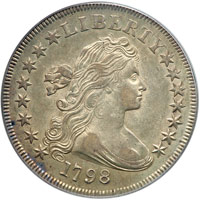 |
1798 B-2, BB-81 Small Eagle 15 Obverse Stars Rarity 3. PCGS graded AU-55+. Subset of PCGS # 6868. In a new secure plus holder. A highly desirable specimen with a nuance of pale champagne gold overlay in the otherwise light natural gray toning on both sides, all of which is underpinned by full satin freshness. Surfaces are pristine. The eye-appeal next to impossible to describe without everyone holding this coin in his hand examining it first-hand. Struck from typically-sharp dies that imported a bold texture to Liberty and the eagle, only the peripheral stars show any rounding at all. The Small Eagle is imbued with luster in the feathers and throughout the surrounding field. Strike is, as on almost all of these, light on the body and legs. On the other hand, the wreath is finely detailed, while the legend is sharp as well. To reiterate: superb surfaces; perfect rims that serve to balance the well-centered strike; no problems of any kind. This offers the sophisticated buyer infinite possibilities while acquiring a World Class Type or Variety set of early Bust Silver Dollars. Pop 1; none finer at PCGS for the variety.
Die notes: BB-81 is the only 1798 dollar with 15 stars. "Undoubtedly, this die was made in 1795 or before June 1796, during which time 15 stars were standard; the die was complete except for the date," underscores the Bowers encyclopedia. "In 1798 the uncompleted die had the date added and was used to coin this variety. (Alternatively and less likely, it could have been a die cutting error similar to the 1817 15-star cent.)
"The highest wave of hair is incomplete, probably from relapping, which also caused certain lower hair curls to be incomplete. B and R in LIBERTY each tilted slightly right.
Wide numeral 8 in date; with top interior space of 8 a horizontal oval and the bottom a circle; a punch unique to this obverse, not used elsewhere in the early dollar series (not for the 8 on later dates such as 1800, 1801, etc., which have vertical oval spaces within the 8). This distinctive 8 punch was regularly used on 1798 $10 gold coins. It is possible that the obverse die was made circa 1795 but with just the first three date digits, 179, punched in; the final 8 could have been added in 1798 by selecting a punch from the wrong font. Squared-off bottom to 7." Obverse die used to strike 1798 BB-81 only (PCGS # 40007) .
Estimated Value $45,000 - 50,000.
The Dr. Hesselgesser Collection.
View details and enlarged photos
Check results on similar lots
| Realized
$42,550 |
Lot 1277 |
 |
1798 B-32, BB-91 Knob 9, 5 Lines High Rarity 6. PCGS graded MS-61. Subset of PCGS # 40008. In a new secure plus holder. Condition Census. Another prestige-drenched specimen, smooth and mar-free surfaces put on a show with their rich pale gold and even old-silver patina, the overall appearance greatly reinforced by excellent centering on a perfect planchet. Regarding this date Bowers, in his encyclopedia of Bust Silver Dollars says, "I estimate that about 10 to 20 exist of the variety here described as BB-91. The record is not clear on these, for over the years the appellation "Bolender-32," equivalent to BB-91, has been assigned to a number of different unusual and/or otherwise unlisted issues. This obverse was earlier mated with a Small Eagle reverse (style of 1795-1798) to create BB-82, a variety minted early in 1798. Accordingly, BB-91 was probably one of the earliest varieties struck with the Heraldic Eagle reverse."Pop 1; none finer at PCGS for the variety. The Finest Known BB-91.
The reverse on this rare issue has the Large Letters reverse from 1796 type font (larger interior space in A, open S, etc.); 5 lines in each vertical shield element. This was one of the first Heraldic Eagle reverse dies cut in early 1798. Upper part of eagle's beak touches ray of star slightly in from its tip; star points to upper left serif of U in PLURIBUS. Line star pattern. Three stars on left between eagle's beak and clouds-are more in a slightly curved line than in form of a triangle. Leftmost star is puny and undersized. Two eagle claw nails show within talons. Leaf points close to left corner of I in AMERICA, and 4th outside leaf tip is under right base of R in AMERICA. Tip of branch points to tip of rightmost tail feather (compare to reverses of BB-117 and BB-118, the only other 1798 reverses in which this is the case). Berry fairly close to right side of serif of left foot of A. Only 10 perfect arrows, one faint arrow, and two sticks (one of which extends to below center of I in UNITED). Three rightmost perfect arrows each have other arrows on top of them, with arrowheads visible part way down shafts. Raised die defects at AT in STATES.
Reverse die used to strike 1798 BB-91 (earlier use) and BB-92 (later use) (PCGS # 40009) .
Estimated Value $50,000 - 55,000.
Ex: Cardinal Collection; Ex: San Marino Collection; The Dr. Hesselgesser Collection.
View details and enlarged photos
Check results on similar lots
| Realized
$34,500 |
Lot 1278 |
 |
1798 B-3, BB-94 Knob 9, 4 Lines Rarity 5. PCGS graded AU-50. Subset of PCGS # 40012. In a new secure plus holder. Condition Census. This is a relatively obtainable variety from this scarce year in the Bust Dollar series, and is a real prize as such because the surfaces are so faultless. Choice for the grade, the surfaces display mid-level old-silver patina over both sides, with the only noticeable drawback being softness on the reverse detail (as struck) from a possibly worn die. There are no marks. The rims are clean, although the reverse dentils are wider on the left and narrow to invisibility on the right from minor misalignment with the obverse die.
In the context of 1798 Heraldic Eagle dollars, BB-94 is one of the rarer varieties. Probably, 31 to 75 are known, as per the Bowers encyclopedia estimate, "most of which are in lower grades up through Very Fine. At the EF level, BB-94 is rare, and higher grade pieces are rarer still. The only Uncirculated piece I have encountered in the literature is that in the Bolender Collection, 1952, since untraced; the grade equivalent of this coin today is not known." Pop 1; none finer at PCGS for the variety (PCGS # 40014) .
Estimated Value $7,000 - 8,000.
The Dr. Hesselgesser Collection.
View details and enlarged photos
Check results on similar lots
| Realized
$7,360 |
Lot 1279 |
 |
1798 B-7, BB-95 Knob 9, 4 Lines Rarity 5. PCGS graded EF-40. Subset of PCGS # 40012. In a new secure plus holder. Condition Census. A first-rate Extremely Fine specimen with a dusky overlay of faint gold and medium gray toning on both sides. There is a small carbon spot at the 4th star. Nicely struck and nearly full, however just a hint of limitation in the detail at the shoulder and on a bit of the scroll at PLUR. As fine an assembly of character traits as you will ever see on one of these, from the color to the surface originality and on through the visual aspects plus choice rims. No more hunting for a better specimen once you put your winning bid on this BB-95 1798 Dollar. Pop 1; none finer at PCGS for the variety (PCGS # 40015) .
Estimated Value $6,000 - 6,500.
The Dr. Hesselgesser Collection.
View details and enlarged photos
Check results on similar lots
| Realized
$4,255 |
Lot 1280 |
 |
1798 B-17, BB-101 Pointed 9, 5 Lines Rarity 5. PCGS graded AU-53. Subset of PCGS # 40016. In a new secure plus holder. Condition Census. Smooth amber-golden iridescence permeates the areas around the date and some of the stars this attractively preserved beauty with a life of its own. The reverse has its own character, which includes a similar light to medium base-gray but deepens within the shield to an almost charcoal gray hue. Add a sky-scraping level of detail from a relatively sharp strike and the appeal is very tempting. Pop 1; none finer at PCGS for the variety.
Rarity estimate from Bowers: 1798 BB-101 is another rare variety. Probably about 31 to 75 are known, most of which are well circulated. The average grade of F-19 is one of just a few to dip below the VF category. An AU or Mint State coin, if such could be found, would be regarded as a landmark item.
Haseltine's was only Good, the only one he ever found. In his 1881 Type-Table, he used his favorite adjective, "excessively," which he used excessively, to describe the rarity of this variety. Bolender only ever saw one, the VF coin that landed in his collection. The fact that numerous specimens have appeared since then, is testimony to the potential "out there" for locating still more examples of erstwhile and present rarities. Only a small number of 1798-dated dollars in numismatic circles have ever been attributed to Bolender numbers (PCGS # 40017) .
Estimated Value $9,000 - 10,000.
Ex: Cardinal Collection; The Dr. Hesselgesser Collection.
View details and enlarged photos
Check results on similar lots
| Realized
$8,913 |
Lot 1281 |
 |
1798 B-22, BB-104 Pointed 9 Wide Date Rarity 4. PCGS graded MS-61. Subset of PCGS # 40018. In a new secure plus holder. Baking fresh luster still gleams on satiny surfaces. A touch of weakness is seen at the central hair curls on the obverse, but here it is probably that the dies were spaced just far enough apart to prevent stronger metal flow in that area or that the pressman, who operated the hand-thrown striking arms just didnít give the motion enough gusto when slamming the two dies together. These early pieces, rather than being "struck" in the modern sense, were more properly squeezed between the dies under immense pressure. Old copper-plate engravings from the era show the large screw-shaped central cylinder which, when set in motion by the pressman, caused the dies to come together with increasing force as the screw pressed downward to its full striking force.
Arc star pattern on reverse. This variety incorporates Obverse 7: Wide date, the 8 firmly united with bust. This die is similar to BB-101, but the upper stars, while near L and Y, are not as close to them as in BB-101; on this the 7th star points directly at the lower left serif end of L, while on BB-101 the star points slightly above the serif end. Second star points to a space between two denticles, third to left part of a denticle. Flaw on star 4. Slight die crack under Y and 8th and 9th stars, shows on some specimens. The obverse die was used to strike 1798 BB-104 (early state) and BB-105 (early and late states).
The reverse, Reverse G in Bowerís system: Branch with five medium sized berries, the two top ones closest together. Leaf point below lower left corner of I in AMERICA. Star distant from eagle's beak. Arc star pattern. 13 arrows.
In 1950, Bolender wrote this: "Die break from milling down through right part of E in STATES to clouds. This break has been seen on all specimens examined. Die breaks through last S in STATES and top of OF. Light die crack from top of N to base of D in UNITED."
Reverse die used to strike 1798 BB-103 (early and late states) and BB-104 (intermediate states). Condition Census #1. Pop 1; none finer at PCGS. One of the two Finest Known BB-104 dollars, possibly the Finest Known. (PCGS # 40021) .
Estimated Value $40,000 - 50,000.
The Dr. Hesselgesser Collection.
View details and enlarged photos
Check results on similar lots
| Realized
$28,750 |
Lot 1282 |
 |
1798 Large Eagle B-23, BB-105 Rarity 3. NGC graded EF-45. Nicely toned with semi-reflective surfaces on the reverse. The obverse for this variety was used earlier to strike BB-105. This reverse (also used to strike BB-106) includes several die flaws, one between ST, another between TE, another at right of E in STATES. There is a curved die flaw above third upper right star on reverse. 5 small berries, the two above closest together. The leaf point is under left foot of I in AMERICA. Star distant from eagle's beak. Introduced in 1798 is the arc star pattern; a star ray points to the center of B in PLURIBUS. 13 arrows. An affordable variety.
Estimated Value $4,000 - 4,400.
View details and enlarged photos
| Realized
$3,910 |
Lot 1283 |
 |
1798 B-13, BB-108 Rarity 3. NGC graded EF-45. Point 9, 10 Arrows. Frosty and lightly toned. A respectable grade for this Rarity-3 BB-108 variety. Quality is often hit-or-miss due to insufficient die pressure leaving behind soft, rounded features that are most noticeable on the hair curls and upper shoulder drapery, for instance. Nevertheless this is an actively collected design, the first in a short run of Large Eagle dates and varieties, 1798-1803. On the reverse we note similar weak strike areas but all is overlaid by nice golden highlights on the injury-free surfaces. Pop 3; 8 finer at NGC for the variety .
Estimated Value $3,800 - 4,000.
View details and enlarged photos
| Unsold |
Lot 1284 |
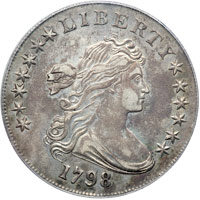 |
1798 B-10, BB-109 Pointed 9 Close Date Rarity 5. PCGS graded EF-45 PQ. CAC Approved. Subset of PCGS # 40018. In a new secure plus holder. Condition Census. Five small berries on the branch on the reverse, the two uppermost being closest together. Arc star pattern. Star slightly distant from eagle's beak; star ray points to center of B of PLURIBUS. 13 perfect arrows, some formed better than others. Leaf points to just left of center of upright of I in AMERICA. A die flaw (chip out of die) under end of stem. Berry under right foot of A in AMERICA (compare to the reverse of BB-111, with the berry under the left foot). All specimens seen are lightly struck on the eagle.
Note: As the obverse was used later to coin more 1798 BB-108s, one wonders what happened to this reverse die. Why was its use interrupted. Perhaps, somewhere "out there" is a BB-109 exhibiting a sudden, massive reverse die failure.' Reverse die used to strike 1798 BB-109 only.
1798 BB-109 is another scarce issue. It may be that no more than 31 to 75 exist, nearly all of which are in lower grades. Opinions concerning the rarity of this variety have been the subject of debate. Bolender suggested Rarity-4 (76 to 200 known, if he used the Sheldon Scale), which may be correct at the rarer end of the spread. Others have suggested that fewer than 30 exist. BB-109 is always weakly struck on the eagle and at the center of the bust. Pop 1; 1 finer in 50 for the variety (PCGS # 40026) .
Estimated Value $7,000 - 8,000.
The Dr. Hesselgesser Collection.
View details and enlarged photos
Check results on similar lots
| Realized
$7,188 |
Lot 1285 |
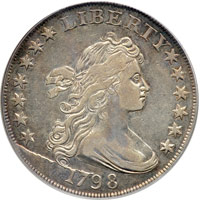 |
1798 B-16, BB-110 Pointed 9 Close Date Rarity 6. PCGS graded EF-45. Subset of PCGS # 40018. In a new secure plus holder. Condition Census. One of the great rarities known with only 6-12 examples estimated to have survived. Unstoppable originality erupts flamboyantly beneath the natural "antique silver" highlights, while gusts of medium toning farm out across the plain creating an aura at the edges of the design elements that is slightly darker than on the main device. The strike is more dependent on BB-110 than on other varieties due to the way the die deteriorated, with strong detail save for a limited area of lightness at the date, and affecting the ribbon scroll on the reverse.
1798 BB-110 is one of the great rarities of the year 1798. Probably, no more than 13 to 30 are known. Estimates of the surviving population have varied widely, to as low as 6 to 12 coins. In his 1881 Type-Table, J.W. Haseltine called this variety very rare. Pop 1; 2 finer at PCGS for the variety, 1 in 50, 1 in 62 (PCGS # 40027) .
Estimated Value $6,000 - 6,500.
The Dr. Hesselgesser Collection.
View details and enlarged photos
Check results on similar lots
| Realized
$5,750 |
Lot 1286 |
 |
1798 B-11, BB-111 Pointed 9 Close Date Rarity 3. PCGS graded VF-35. Subset of PCGS # 40018. In a new secure plus holder. A worthwhile example by any standard, the field is not only smooth and unimpaired by marks or spotting, but it is also resolute in its light to medium gray tone. The highest design areas have a normal "rubbed silver" appearance (almost dove-gray by comparison), while medium old-silver color expands across the fields and depths on both sides. The strike, like the luster, is confident, indeed, as bold as ever seen on virtually any example of this variety. A die break through the hair seems to have displaced the die causing uneven striking in this area. Choice rims to go with the pleasing strike and color. A fresh original specimen. If one wanted to be picky, there is a tiny scuff in the obverse field that Libertyís eye seems to be focusing on. But this is minimal given the overall pleasant character of the coin.
Die characteristics as described by Bowers include: Medium wide date, 10 mm. across at bottom widest place. First star about as far from curl as upper right star is from Y. The upper left star is closer to L in LIBERTY and about the same distance as last star is from bust. On the left, stars 2-3, 3-4, and 6-7 are spaced wider apart than are the others. On the right, stars 8, 9, 10, and 11 are spaced farther from each other than are stars 11-12 and 12-13. A small clash mark shows just beneath ribbon bow along two highest curls at back of head.
Die State VII: Bolender-11b. The die crack across the hair continues across the cheek, mouth, and upper ray of last star to border. "This die state is always weak at the obverse center" according to Bowers, and as seen in this Lot (PCGS # 40028) .
Estimated Value $2,800 - 3,000.
The Dr. Hesselgesser Collection.
View details and enlarged photos
Check results on similar lots
| Realized
$2,645 |
Lot 1287 |
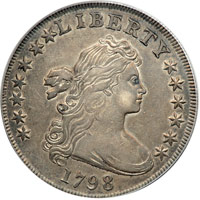 |
1798 B-15, BB-112 Pointed 9 Wide Date Rarity 3. PCGS graded EF-45. Subset of PCGS # 40018. In a new secure plus holder. Scarce Die State I. According to the BB book this coin with large stars and no die cracks may not exist, but here it is! Quite desirable. A gorgeous coin with the right mix of qualifications in its grade class to entice active, interested buyers. The highlights include a touch of residual luster in and around devices mingled with smooth finish and light to medium gray toning. Adequately struck as well, not fully so, but near enough to merit mention here. Pop 1; 2 finer for the variety, 1 in 50, 1 in 58 (PCGS # 40029) .
Estimated Value $5,000 - 5,500.
The Dr. Hesselgesser Collection.
View details and enlarged photos
Check results on similar lots
| Realized
$4,830 |
Lot 1288 |
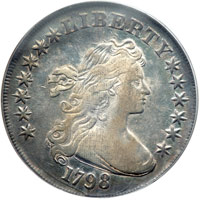 |
1798 B-28, BB-118 Pointed 9 Close Date Rarity 3. PCGS graded VF-35 PQ. Subset of PCGS # 40018. In a new secure plus holder. Another respectable example from the 1798 emission, and of the most advantageous order for a collector due to its overall choiceness. Its high degree of medium to dark toning rises and falls around and over the highlights. Nicely struck, too, with just a small amount of weakness at the usual Achilles' heel in a vertical band across the centers on both sides (PCGS # 40035) .
Estimated Value $3,000 - 3,300.
The Dr. Hesselgesser Collection.
View details and enlarged photos
Check results on similar lots
| Realized
$2,933 |
Lot 1289 |
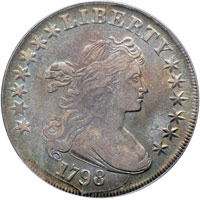 |
1798 B-29, BB-119 Pointed 9 Close Date Rarity 4. PCGS graded EF-40. Subset of PCGS # 40018. In a new secure plus holder. Last use of obverse die. Always weakly struck. 1798 BB-119 is scarce. Probably about 76 to 200 exist, most of which are in lower grades through VF. EF coins are quite rare, and AU specimens are extremely rare. No Mint State coin has been seen. The one listed was sold in 1970, and may not grade as Uncirculated today.
Obverse die used to strike BB-113 (1st use), 1798 BB-114 (2nd use), BB-115 (3rd use), BB-116 (4th use), BB-117 (5th use), BB-118 (6th use), BB-119 (7th and final use). On the reverse, a star touches lower part of eagle's beak; ray points to just left of U in PLURIBUS. Line star pattern. Five small berries, two above closest together. Leaf points under right edge of upright of I in AMERICA. 13 perfect arrows, an unusual situation. Reverse die used to strike 1798 BB-119 (earlier state) and BB-120 (later state). Pop 1; none finer at PCGS (PCGS # 40036) .
Estimated Value $5,000 - 5,500.
The Dr. Hesselgesser Collection.
View details and enlarged photos
Check results on similar lots
| Realized
$4,370 |
Lot 1290 |
 |
1799 B-13, BB-151 Irregular Date 13 Stars Rarity 5. PCGS graded EF-40. Subset of PCGS # 6880. In a new secure plus holder. An attractive specimen of the best possible order for its grade and one whose surfaces play host to smooth features and no overt marks. The rims, too, are exemplary in a series where rim bruises seem all too common.
Irregular date, per traditional nomenclature, although the "irregular" feature is more notable in the telling than in the seeing. Both 9s are improperly placed, the first is tipped too far to left at top, the last 9 too far to right at top. In BB-151, this obverse is combined with a reverse that has a die "dot" (rust) above E in STATES, and die flaws inside upper part of same letter. Die flaws appear between and under two lower stars farthest to right. Star is close to eagle's beak, and barely escapes touching its upper part; ray points to right side of B in PLURIBUS. Leaf points to center of I in AMERICA. All seen are weakly struck at their centers. Reverse die used to strike 1799 BB-151 only. Pop 1; 1 finer in 45 for the variety (PCGS # 40044) .
Estimated Value $5,000 - 5,500.
The Dr. Hesselgesser Collection.
View details and enlarged photos
Check results on similar lots
| Realized
$4,600 |
Lot 1291 |
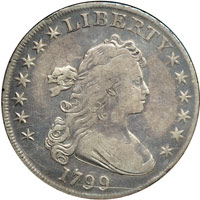 |
1799 B-5, BB-157 Rarity 2 ANACS VF Details Net VG10 Graffiti-Cleaned.
Estimated Value $500 - 550.
View details and enlarged photos
| Realized
$690 |
Lot 1292 |
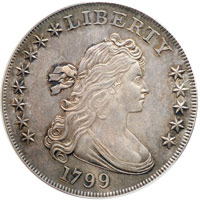 |
1799 B-23, BB-159 Draped Bust 8X5 Stars Rarity 4. PCGS graded AU-58. CAC Approved. Subset of PCGS # 6881. In a new secure plus holder. A high degree of luster distinguishes the satiny silver gray to golden surfaces from others of the date which are less pulsating even though in technically similar grade. Collectors familiar with the series will recognize this difference at once. The stars seem to have attracted the deepest toning, and so too the outer areas on the reverse around the lettering. This is a well-struck example with superb details. It has no bothersome abrasions or points of wear. The dies smacked the planchet with full force, imparting all their intricate design.
The distinguishing feature of BB-159 is that there are only 5 stars to the right of the bust. The obverse stars are arranged eight to the left and five to the right; the only 1799 with this peculiar arrangement. The reason for this configuration is unknown. It may have been a blundered die, or the engraver may have accidentally punched the eight stars on the left after just having cut a die for a 1799 $10 gold coin (all of which have stars arranged 8x5 this year). He would then have been forced to complete the die using only five stars on the right. Given the care taken to prepare dies at the Mint for dollar coinage this year, the 8x5 stars was the result. Pop 1; none finer at PCGS for the variety (PCGS # 40067) .
Estimated Value $14,000 - 15,000.
The Dr. Hesselgesser Collection.
View details and enlarged photos
Check results on similar lots
| Realized
$16,100 |
Lot 1293 |
 |
1799 B-11, BB-161 Normal Date 7X6 Stars Rarity 3. ANACS graded MS-63. Subset of PCGS # 40043. Condition Census. One of the most attractive early dollars in this sale is this 1799 BB-161, a precious choice Mint State specimen that stands has received ANACSís imprimatur as to grade. Attractive frosty surfaces exhibit a milky gold overlay of color, complete and tranquil, encircling the lower reverse, at least at the bottom, a bright amber-gold crescent. The fields are sustaining and immaculate, befitting the grade, befitting a coin with this pedigree, and looking more like a toned silver dollar struck a hundred years later than one made at the end of the 18th century. The strike is as bold as can be imagined, showing full pointed centers to every star on the obverse and on some of those on the reverse. The surface quality surpasses many other early BU dollars known, with no evidence of improvement or alteration, simply fresh originality. The die clash marks that are typical for this variety are vividly pronounced on this impressive specimen.
The present population of 1799 BB-161 is believed to be about 201 to 500. Most of these are of Die State II, according to auction offerings, but probably most were what I call Die State III. While BB-161 is obtainable easily enough in lower grades, in AU the issue is scarce, and in true Mint State it is a notable rarity. Nearly all of the auction appearances for Mint State coins mentioned above occurred well before the revision in grading interpretations that occurred in numismatics beginning in 1986.
Estimated Value $16,000 - 18,000.
The Dr. Hesselgesser Collection.
View details and enlarged photos
| Realized
$18,400 |
Lot 1294 |
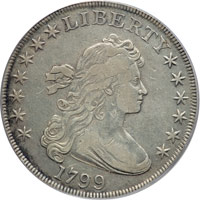 |
1799 B-11, BB-161 Rarity 3 PCGS graded Genuine. Cleaned. Light grey toning deepening at the devices. Our grade is VF30. No berries in branch that the eagle is holding. U in UNITED defective at upper left part, which is cut off, due to the employment of a defective punch. A point of the star touches the point of the lower part of the eagle's beak; a ray points to the left serif at left side of U in PLURIBUS. Star under cloud 1 is noticeably smaller than any other. A in AMERICA rests on 4th feather. Leaf point is under left side of upright of I. Upper right star has only one point touching cloud 8. The present population of 1799 BB-161 is believed to be about 600 to 1,100. Most of these are of Die State II, according to auction offerings. BB-161 is readily obtainable in grades of Good to Extremely Fine (PCGS # 6878) .
Estimated Value $3,500 - 4,000.
View details and enlarged photos
Check results on similar lots
| Unsold |
Lot 1295 |
 |
1799. B-10, BB-163 Rarity 2. NGC VF Details, plugged. Expertly repaired with pleasing grey toning. Die State IV: On reverse, numerous cracks develop: Vertically from border through O, between clouds 7 and 8, toward eagle's head, splits, and branch goes left through a star. Crack from wing, through right ribbon end, into field to left of branch end. Crack from branch to eagle's leg to tail. Crack from interior of branch upward to below ER. Crack from top of A, down through TES, to cloud 5, splits, two cracks go down and to the left, and one goes to right. The die could not have survived long beyond this point. Rare die state.
Estimated Value $500 - 600.
View details and enlarged photos
| Realized
$748 |
Lot 1296 |
 |
1799 B-17, BB-164 Normal Date 7X6 Stars Rarity 2. PCGS graded MS-62. Subset of PCGS # 40043. In a new secure plus holder. Condition Census. Although this obverse die was used to coin BB-156, BB-157, BB-161, BB-162, BB-163, and BB-164, in its use with BB-164, the state is most similar to BB-163, with the "pocket" or "cobweb" (die clash mark) at junction of chin and neck removed by relapping the die. A die crack shows through last 4 stars. A faint crack is near border opposite point of bust. All seen are weak at the centers, especially on the obverse. Obverse die used to strike 1799 BB-156 (with clash marks), BB-157, BB-161 (now relapped), BB-162, BB-163, and BB-164.
On this reverse, we see five extremely large berries in olive branch, the largest on any 1799 dollar. The two upper berries are partly buried in the leaves. Point of star enters eagle's mouth, upper part of beak closing down on star. The point of the star almost touches lower part of beak; ray points to left edge of left serif of U in PLURIBUS. Leaf points near left corner of I in AMERICA. A does not touch feathers. Very short stem in claw; shortest stem on any 1799 reverse. Peculiar raised die flaws resembling an equal sign (=) are at an angle under the star that straddles clouds 2 and 3. An incuse die mark at the upper left corner of the leftmost cloud is present on the early die state; the second S in STATES is repunched at the inside of its lower loop. Far right edge of A is over junction of clouds 3 and 4. The letters in E PLURIBUS UNUM seem larger and in some instances differently proportioned on this reverse (and also on BB-162, a different die), in comparison to the other reverses of the year. Reverse die used to strike 1799 BB-164 only.
As an estimated 501 to 1,000 specimens of the 1799 BB-164 dollar are known, examples are readily available on the market. Most are in grades through EF. AU coins are somewhat more elusive than the overall rarity might suggest. Mint State coins are great rarities. Pop 1; none finer at PCGS for the variety (PCGS # 40055) .
Estimated Value $30,000 - 35,000.
The Dr. Hesselgesser Collection.
View details and enlarged photos
Check results on similar lots
| Realized
$32,200 |
Lot 1297 |
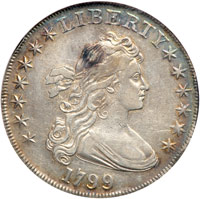 |
1799 B-17, BB-164 Rarity 2. NGC graded AU-50. Light gold and blue toning. A circular toned area noted in the topmost hair. Highly radiant in the fields and across most devices with largely natural light gray patina. There is some blue-gold within the outer margins and smooth fields and highlights on both sides. All but fully struck, with just a insubstantial touch of weakness at the juncture of the right wing of the eagle where it meets the edge of the (sharp) shield. Full strong motto on the ribbon. Full features in the arrows and leaves. Pop 3; 6 finer at NGC for the variety .
Estimated Value $5,500 - 6,000.
View details and enlarged photos
| Unsold |
Lot 1298 |
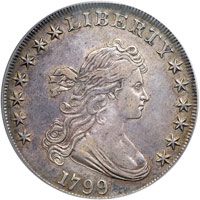 |
1799 B-8, BB-165 Rarity 3. PCGS graded EF-45. Attractive original gray toning. Those collectors wishing to acquire a first-rate Extremely Fine bust dollar of this type, featuring the draped bust and heraldic eagle design of 1798-1803, will want to direct their attention this remarkable coin. It�s beauty is undeniable. It�s natural toning the stuff dreams are made of in a world where coin cleaning seems to all too common. Highly alluring and fully struck, with substantial detail at all stars, hair curls, drapery folds. On the reverse as well, we can report most elements are bold. Exception may be focused at the center where the eagle�s chest and head are the only areas one might fault for not being 100% sharp. But this is secondary in the overall appearance. A desirable coin. Pop 2; 3 finer at PCGS for the variety (PCGS # 40056) .
Estimated Value $5,000 - 5,500.
View details and enlarged photos
Check results on similar lots
| Unsold |
Lot 1299 |
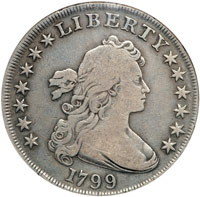 |
1799 B-9, BB-166 Rarity 1. NGC graded VG-8 CAC Approved. Balanced wear, balanced color, and an appreciably nicer appearance than many in this modest circulated grade. Ideal for the collector who wishes to own a representative silver dollar from the late 18th century. It so happens that 1799 is the year George Washington passed away at the age of 67 (1732 to Dec. 24, 1799).
Estimated Value $1,000 - 1,100.
View details and enlarged photos
| Realized
$1,438 |
Lot 1300 |
 |
1799 B-22, BB-168 Normal Date 7X6 Stars Rarity 5. PCGS graded AU-50. Subset of PCGS # 40043. In a new secure plus holder. Condition Census. A glossy coin and a first-rate one in its grade by any benchmark. What's more, this has an engaging veil of pale golden that soar across the center, leaving the neutral gray surfaces elsewhere smooth and free of marks. The strike is affected by the major die break on the reverse and is more than acceptable for the variety, with just a touch of softening on the hair curls and elsewhere.
On this reverse, Reverse P there is a horizontal die crack entirely across center of reverse, from right side of E to left side of M. One arrow extends slightly past right side of upright of N. Star touches lower point of eagle's beak; ray points to left upright of U in PLURIBUS. Leaf point is slightly right of being under center of I in AMERICA. Letter A touches only 3rd feather. U in UNITED is cut off at upper left; made from defective punch (used on three different dies to strike BB-157; BB-158, 159, 161 and 162; and BB-168). Far right edge of A is over cloud 3. This reverse die was used to strike 1799 BB-168 only and its demise and withdrawal from use no doubt caused the limited availability.
With a known population estimated to be in the range of 31 to 75 coins, 1799 BB-168 is at once elusive but sufficiently available that every serious specialist can own one. Most specimens are in lower grades through Very Fine, however. EF coins are very rare. "AU coins?" asks Bowers in his encyclopedia. "Where are they?" Pop 1; none finer at PCGS for the variety (PCGS # 40059) .
Estimated Value $6,000 - 7,000.
The Dr. Hesselgesser Collection.
View details and enlarged photos
Check results on similar lots
| Realized
$6,325 |
Lot 1301 |
 |
1799 B-21, BB-169 Normal Date 7X6 Stars Rarity 3. PCGS graded AU-55. CAC Approved. Subset of PCGS # 40043. In a new secure plus holder. Condition Census. A lock-solid frosty specimen with strong primary luster and rich toned highlights on both sides. More than adequately struck for the date, this is a glorious specimen, perhaps not 100% bold if you take into account the central part of the eagle, since this issue rarely is, but certainly a coin that gets premium marks where preservation and beautiful color is of primary importance to the prospective new owner. Pop 1; 2 finer in 58 for the variety . (PCGS # 40060) .
Estimated Value $8,000 - 9,000.
The Dr. Hesselgesser Collection.
View details and enlarged photos
Check results on similar lots
| Realized
$10,925 |
Lot 1302 |
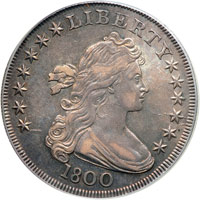 |
1800 B-1, BB-181 Normal Date Rarity 5. PCGS graded AU-53. Subset of PCGS # 6887. In a new secure plus holder. Condition Census. A resplendent example of the finest order for the modest About Uncirculated 53 grade. Some lingering luster graces the reddish golden to champagne and gray surfaces. Sharply struck for the date, easily finer in sharpness than even higher grade specimens, with some minor weakness indicated on the eagle's head and breast along with the right half of the scroll where UNUM disappears. A small mark adjacent to the eagle's neck where the scroll crosses. Otherwise, the fields fresh and free of abrasions. Pop 2; 1 finer in 55 for the variety (PCGS # 40067) .
Estimated Value $6,500 - 7,000.
The Dr. Hesselgesser Collection.
View details and enlarged photos
Check results on similar lots
| Realized
$7,188 |
Lot 1303 |
 |
1800 B-2, BB-182 Normal Date Rarity 6. PCGS graded VF-35. CAC Approved. Subset of PCGS # 6887. In a new secure plus holder. It seems that nothing higher than EF40 is available for this variety, which places this VF35 high on the Condition Census; even so, few are available even in this grade. Smooth gray finish that is lighter on the devices and then deeperns to normal old-silver hues. There are a few light contact marks from its days spent in circulation, far fewer in number than one sees on most Draped Bust dollars in this grade, however. The rims show some of the widest dentils we have seen on 1800.
Bowers writes this about BB-182ís rarity: 1800 BB-182 is one of the great rarities of the year. Only an estimated 13 to 30 are known to exist. Years ago, the issue was regarded as unique. J.W. Haseltine knew of only one, and M.H. Bolender stated the same, noting that it may have been the Haseltine specimen that came under his view. Thus, when Bolender's book went to press in 1950, it was believed that there was just a single coin extant.
Since then, additional pieces have been recognized. BB-182 is not only remarkable for its rarity, but also for the fact that all known specimens show evidence of circulation. Among examples which have been reported, not a single piece makes the AU level. It appears that the finest grade is about EF40.
Estimated Value $3,000 - 3,300.
The Dr. Hesselgesser Collection.
View details and enlarged photos
| Realized
$3,450 |
Lot 1304 |
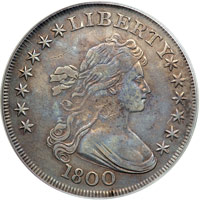 |
1800 B-20, BB-185 Normal Date Rarity 6. PCGS graded EF-45. Subset of PCGS # 6887. In a new secure plus holder. Condition Census. Minor weakness in centers, as struck. Variegated toning over both sides with russet-gold to light steel-blue predominant. The upper right star on BB-185 is in position similar to the obverse of the 1804 dollars, with two points almost touching Y. This obverse was not known to Haseltine when he compiled his Type-Table in 1881. Obverse die used to strike BB-185 only.
On the reverse, die flaws show at top and to right of ES, easily identifying this die which was also used for BB-186 and BB-187. Lower right serif of F is extremely close to or touches cloud 8; the only reverse of 1800 with this characteristic. Reverse die used to strike 1800 BB-185, BB-186, and BB-187, possibly in that order.
Only about 13 to 30 are known of the 1800 BB-185, believed to be the rarest variety of the year. Bolender knew of only a single undamaged specimen of this variety, stating it was "as rare as an 1804." Since that time, other examples have come to light. Pop 1; none finer at PCGS for the variety (PCGS # 40071) .
Estimated Value $6,500 - 7,000.
The Dr. Hesselgesser Collection.
View details and enlarged photos
Check results on similar lots
| Realized
$6,900 |
Lot 1305 |
 |
1800 B-16, BB-187 Rarity 2 NGC graded XF Details. Improperly cleaned. The color is now a light silver-gray hue which will, in time, mellow to natural antique shades and lessen the visual effects of the cleaning. Popular turn-of-the-century issue. Draped Bust Dollars were struck in 1798-1803. Most, however, instead of circulating locally, tended to be exported in competition with the similar-sized Spanish and Mexican 8 reales coinage of the day.
Estimated Value $1,800 - 1,900.
View details and enlarged photos
| Realized
$2,128 |
Lot 1306 |
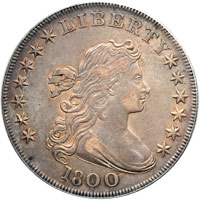 |
1800 B-11, BB-191 Wide Date Low 8 AMERICAI Rarity 5. PCGS graded AU-50 PQ. CAC Approved. Subset of PCGS # 86888. In a new secure plus holder. Condition Census. Another lustrous golden gray exa mple which has grand overall eye appeal. The above-average strike complements this eye-appeal and, some might say, adds immeasurably to the appearance. Suitable for the finest Type set due to the careful consideration the consignor gave to its acquisition.
1800 BB-191 dollars survive to the extent of an estimated 31 to 75 coins, ranking it among the scarcer issues of a year with many elusive varieties. The desirability of BB-191 is greatly increased by the AMERICAI feature on the reverse, a stray mark from a punch that is in the right position to make it appear (with some imagination) as the letter I, hence AMERICAI. Pop 1; 1 finer in 58 for the variety .
Estimated Value $10,000 - 11,000.
Ex: Cardinal Collection; Ex: Joel Cheek Collection; The Dr. Hesselgesser Collection.
View details and enlarged photos
| Realized
$11,500 |
Lot 1307 |
 |
1800 B-19, BB-192 Close Date AMERICAI Rarity 2. PCGS graded MS-61. Subset of PCGS # 6892. In a new secure plus holder. A significant offering of what is surely one of the desirable Condition Census examples of the variety. Warm golden gray surfaces exhibit strong luster and a satin, almost matte-like quality that really engages the aesthetic sense with its serene beauty.
The AMERICAI variety is something of a mystery; the question is asked, what was the cause of the reverse die flaw that slightly resembles an wayward I in the field? Bowers gives his opinion that the stray mark is "perhaps from a punch or from a stray piece of metal during the die making process … ." Breen, in his Complete Encyclopedia, suggested that the errant letter might be "the right leg of a mostly effaced A," although close examination of the mark indicates that this is not the case. Whatever the reason, the desirability of this variety has continued to this day. BB-192 is the more common of the two AMERICAI 1800 dollar varieties, though both are legitimately rare in Mint State. Rich, satiny luster blankets both sides of this boldly impressed early dollar. Those seeking a high end specimen of this popular variety will prudently watch to the current offering. Pop 1; none finer at PCGS for the variety (PCGS # 40082) .
Estimated Value $25,000-UP.
The Dr. Hesselgesser Collection.
View details and enlarged photos
Check results on similar lots
| Realized
$27,600 |
Lot 1308 |
 |
1800. 12 arrows. B-13; BB-193, Rarity 4. Sharpness of Fine-12. Burnished, holed and repaired.
Estimated Value $500 - 600.
View details and enlarged photos
| Realized
$748 |
|
|